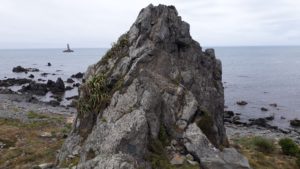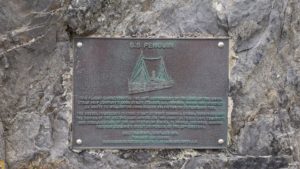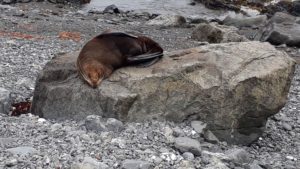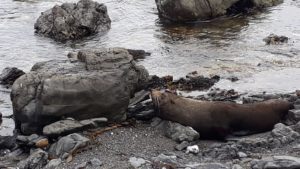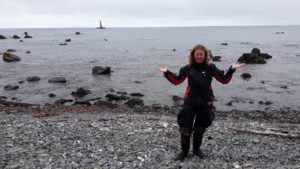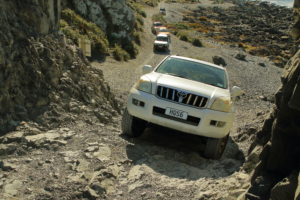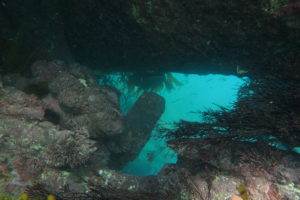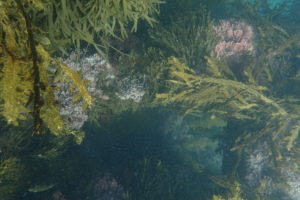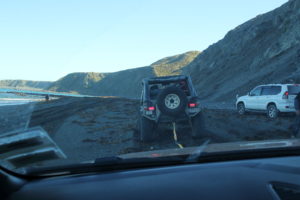After Christmas lunch, sitting around and relaxing; the subject of an unknown wreck pricked the ears of the divers in the room.
“Grandad’ was bought up and later worked around Terawhiti Station, near Red Rocks and used to snorkel a wreck in that area. The wreck of the SS Penguin was mentioned but the location of this wreckage is still unknown. Though there is a memorial plaque nearby as it is thought to have struck rocks in the area in 1909.
After convincing ‘Grandad’ to be our guide a 4WD expedition was planned and a couple of weeks later we found ourselves over Devils Gate and around the coast towards Karori Lighthouse. ‘Grandad’ certainly knew the area and it’s history, though the story behind Frenchies Bay was not the one I was expecting. We ended up at Dip Bay – inventively named after the sheep dip trench up on the beach.
We scoped out the bay and made a plan to search for the wreck. We knew the wreck was in shallow water as ‘Grandad’ used to snorkel it and that it was relatively close to shore. We decided to swim out to the offshore rocks and then perform a u-pattern search back in. And while many rocks looked like wreckage as we approached we found no evidence of a wreck in this area.
Oh well – we had an adventure, explored a new site and enjoyed a great day out with friends and family.
PS: We saw seals!
Fast forward a couple of months and I hear Paddy & Simon talking about a variety of wrecks around Wellington and whether or not they would be worth a dive to see what was there. As they rattle of some ship names and locations, Paddy mentions Sheep Dip Bay which sounded familiar so I went over to see what they were looking at and a photo of the wreck site caught my eye. So I found photo that we took on our dive in January.
Notice the rock above my left hand and below the oval in the right hand picture.
Yep – that’s right we were so close to finding the wreck – now known to be the Woollahra.
The Woollahra was an iron barque of 974 tons, 202.4 ft. length, 33.6 ft. beam, and 20.4 ft. depth. It was built in England in 1875 and used to transport coal between Sydney and Wellington.
The Woollahra site is historically significant as the wreck of an 1870s colonial built iron hulled vessel. While ensuring his passengers and crew made it ashore safely in the lifeboats, the master, Captain Anderson and one other crew member lost their lives.
The loss of vessels such as the Woollahra in 1907, the Nambucca in 1905, and the Penguin in 1909 lead to the construction of a lighthouse on Karori Rock which was lit in 1915. (The lighthouse can be seen in the above photos)
After finding this evidence of wreck in the same area ‘Grandad’ used to snorkel we knew we were on the right track and planned another trip out on Good Friday with the support of the Cross Country Vehicle Club who got us out there and back again!
With a better idea of where to dive, and some surface swell, we decided to enter in through a narrow channel between the rocks, almost beaching ourselves at low tide. I hadn’t even gotten in when we heard that the first buddy team had found an anchor – right at the end of the channel in ~3m of water. We had found the wreck with no hunting required.
The wreckage is scattered over a wide area in ~4m of water. With some large intact sections, including the bow, masts and large sections of the hull remaining. More research is required to identify parts of the wreck but if you have the opportunity to get out to this area it is worth the dive.
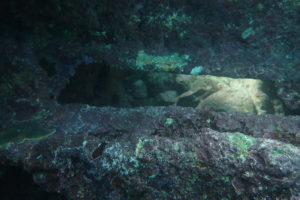

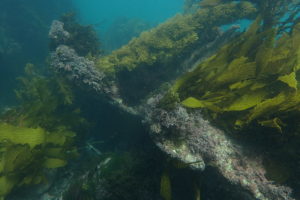
I am definitely looking forward to our next adventure, hopefully with less surge so we can get a better idea of the site and the wreckage in this area.
Claire
PS: To say thanks for reading to the end here is a photo of one of our divers getting rescue by the team from Cross Country Vehicle Club
